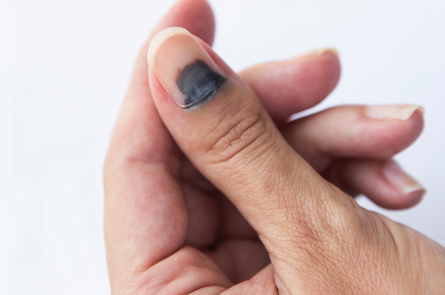Subungual Hematoma – Treatment
Trauma
Context
- Subungual hematomas are an accumulation of blood beneath the fingernail or toenail, usually caused by direct crushing trauma to the digit that results in bleeding of the nail bed (Figure 1).
- Patients usually present with throbbing pain and swelling of the digit.
- Blue-purple-black discoloration beneath the nail.
- Nail and nail folds may be intact or may have injury (e.g. nail laceration).
- Consider x-ray if significant pain.
- Treatment may not be necessary if the subungual hematoma is not acutely painful for the patient and it is not accompanied by other injuries to the digit.
Recommended Treatment
Trephination
- Trephination is preferred over nail removal for subungual hematomas that are painful and have intact nail folds.
- Trephination puts holes in the nail plate to drain the subungual hematoma which alleviates pain and promotes healing of the nail bed. This can be achieved using:
- Electrocautery
- Presterilized needle
- Bunch biopsy
- Whichever method is used to trephinate the nail plate, penetrating too deeply to the nail bed must be avoided.
- After trephination, the digit should be kept dry and clean and should not be soaked.
Nail Removal
- Removal of the nail plate is only recommended for subungual hematomas accompanied by nail bed lacerations (e.g. fingertip or toe avulsion).
- Removal of the nail plate for nail bed exploration is not recommended for subungual hematomas with:
- Intact nail plate and nail folds.
- At least partial adherence of the nail plate to the nail bed.
- It is no longer recommended to remove the nail plate when the subungual hematoma exceeds 25-50% of the nail plate surface as there is no difference in short or long-term healing outcomes between trephination and nail removal.
Prophylactic Antibiotics
- There is no evidence that supports the use of prophylactic antibiotics to reduce infection after trephination of subungual hematoma.
- Subungual hematomas associated with an open fracture may require prophylactic antibiotics depending on the type of fracture and other patient factors (discussed elsewhere).
Tetanus Prophylaxis
- Review of tetanus immunization status should be completed for patients with subungual hematoma accompanied with a wound such as:
- Wounds contaminated with dirt, feces, saliva
- Puncture wounds
- Avulsions
- Wounds resulting from crushing, burns, foreign objects
Other Resources
Related Information
Reference List
Relevant Resources
RESOURCE AUTHOR(S)

DISCLAIMER
The purpose of this document is to provide health care professionals with key facts and recommendations for the diagnosis and treatment of patients in the emergency department. This summary was produced by Emergency Care BC (formerly the BC Emergency Medicine Network) and uses the best available knowledge at the time of publication. However, healthcare professionals should continue to use their own judgment and take into consideration context, resources and other relevant factors. Emergency Care BC is not liable for any damages, claims, liabilities, costs or obligations arising from the use of this document including loss or damages arising from any claims made by a third party. Emergency Care BC also assumes no responsibility or liability for changes made to this document without its consent.
Last Updated Feb 18, 2021
Visit our website at https://emergencycarebc.ca
COMMENTS (0)
Add public comment…



POST COMMENT
We welcome your contribution! If you are a member, log in here. If not, you can still submit a comment but we just need some information.